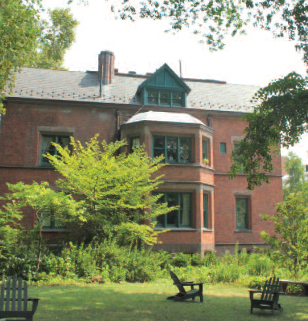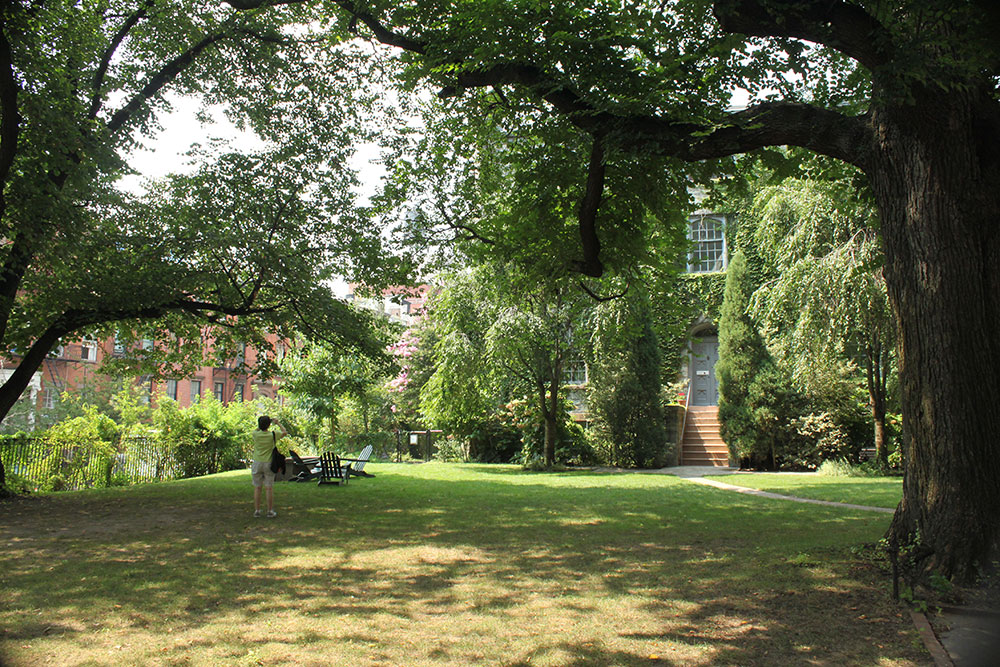 |
| Jim Naurekas |
One of New York City’s most popular new attractions is the High Line, an elevated park that follows an old railway trestle along the West Side of Manhattan.
Adjacent to the brand-new park is one of the city’s oldest institutions, The General Theological Seminary of the Episcopal Church (GTS), which moved to the neighborhood in 1827.
As in all of theological education, past performance is no guarantee of survival, and the seminary was perilously close to failure in 2010. In previous years, the school’s leaders had faced operating losses, but they had planned to offset them with real estate ventures. They collaborated with a developer to replace the administration building on the east side of campus with a condo tower — which also houses the seminary’s new library on its lower floors. Across the quad, they built a boutique hotel and conference center facing the new High Line park. But neither of these brought financial stability.
As the former dean-president retired, the board decided to split the job into two — an interim dean to handle academic affairs and a president to focus on the business plan. As president, they chose the Rev. Lang Lowrey III, then 56, the vicar of St. Benedict’s Episcopal Church in Smyrna, Georgia.
Before attending the Candler School of Theology and being ordained to the Episcopal priesthood, Lowrey was a business executive who had helped two Fortune 500 companies through turnarounds. In 2004, as a newly ordained priest, he started a new parish and school in the growing northwestern suburbs of Atlanta.
As planned from the beginning, Lowrey has just departed after three years at the helm of GTS. In Trust recently talked to him about revitalization at the seminary.
The board of trustees appointed you as president of The General Theological Seminary on June 9, 2010. Describe the situation you encountered your first day on the job.
The financial state at GTS was bleak. As a businessman, I had watched organizations struggle financially, but I had never seen an institution in such a state. It was not a matter of, “We’re going to hit the iceberg in a year or six months.” We had already hit the iceberg, and the trustees wanted somebody on board who had experience with sinking ships.
 |
| Jim Naurekas |
We were also out of money. Even if we stopped paying our debts, we didn't have the ability to continue operations. In the corporate world, declaring bankruptcy can be helpful — a strategic step in a comeback plan. In the case of a seminary, that isn't an option. It’s hard to attract students to a failing institution or one in financial exigency.
What did you do first?
I got in a cab and went to the bank to negotiate a stay of execution — they were getting ready to foreclose on us — and to borrow more money. I had to build the case that it would not be pretty for a bank to close the doors on a New York City landmark. They agreed to make a swing loan to give us time to pull together a plan and get it approved at our trustees’ October meeting.
While this situation was unfolding in the boardroom, what was happening in the classrooms?
To their credit, the dean and others had found a way to keep the institution moving forward. Not only did they keep the lights on, the meals coming, and the professors motivated, they also were doing a good job of educating leaders for the church. That said, we — like most seminaries — had room for improvement. The church is changing and we needed to change with it.
What were early indicators that the seminary was headed for a meltdown?
The most obvious warning sign was the dramatic drop in the endowment. For the past decade the school had depleted the endowment to cover operating losses. When I came in, those losses were at $7 million a year, and the endowment was down to about $11 million. We were under water. Legally, GTS couldn't draw from the endowment anymore.
At the same time, the school was receiving residual payments from a piece of land it had sold years earlier. To some folks, this income appeared to offset the operating losses. But outside experts cobbled together a more accurate picture. They projected a financial meltdown to occur at almost the exact time that it did.
 |
The bucolic General Seminary campus - before part of the property was sold and developed.
Shelly Stein |
Did GTS have any plans to address the deficit beyond dipping into the endowment?
One strategy was to operate a former student housing unit as a boutique hotel. This didn't pan out and never contributed in a meaningful way to the bottom line. My advice to the board — to all boards — is to stick to your core competencies.
Besides the hotel, GTS was counting on a rising tide of students. We've had record attendance the past few years, but that’s an anomaly. The Episcopal Church is not growing, just as many mainline churches are not growing. So we have to presume that fewer students will be attending seminary in the immediate future.
What governance structure was in place when you arrived? Were the trustees open to your recommendations for change?
The board was large, 45 trustees, but lacked key financial expertise. In retrospect, the crisis was a godsend because it eliminated all sense of confusion. We never could have made the necessary changes to right-size the business without the board and staff embracing the reality of the situation.
You recruited new talent?
Yes. Some people might argue that a seminary should wait for God to turn things around. I see us as the hands and feet of God, and we've got to do our part. To this end, we brought in a top CPA as our auditor, an experienced fund manager to oversee investments, a treasurer who had served as chief financial officer in the corporate world, and a chancellor who was a lawyer. Together they made a huge difference.
Did you reduce the size of the board?
The overall board stayed the same size; it’s a good mix of bishops and laypeople who represent various constituencies. The members serve on committees — we call them commissions — in keeping with their interests and expertise. Because a 45- member board can be unwieldy when it comes to decision making, we have an executive committee of about ten members with key skills. A new board chair, a very accomplished retired bishop of New York, heads the executive committee that meets once a month to determine recommendations to bring to the full board for action.
The agenda for executive committee meetings is set jointly by the committee and the dean. This is a change from the past when it was easier to avoid items that hinted of impending doom. As the school’s leader, I could not skirt a problem. If we couldn't get an issue on the agenda one month, we addressed it the next month.
With key people in place, how did your team go about designing a comprehensive plan to save GTS?
Our plan was to “Choose life,” and we pulled that out of Deuteronomy chapter 30. We likened ourselves to the Israelites, who were in bondage and chose the path of liberation, no matter how tough it was. I compiled the plan, got the opinions of some objective outsiders, and brought it to the executive committee. Our trustees approved the plan and gave me the authority to execute it with the executive committee’s oversight.
 |
The bucolic General Seminary campus - before part of the property was sold and developed.
Credit: Shelly Stein |
What was the content of the plan?
It had three major parts. First, we needed to sell several buildings. This included the hotel but not the conference center.
Second, we wanted to build a new library and needed to secure a gift from a potential donor that our previous dean had identified.
Third, we had to raise funds to eliminate our debt and reduce deferred maintenance. We accomplished the first — selling properties — and that gave us working capital to make headway with the third — addressing deferred maintenance. We also were able to pay off the swing loan from the bank.
How did you manage all this and simultaneously run the academic side of the seminary?
We separated the offices of president and dean and recruited a top bishop, Peter Lee, to serve as dean. This enabled me to give 100 percent of my time to addressing the financial crisis and reengineering a business model.
How did you raise money aside from divesting real estate?
We launched an annual fund to stimulate giving among stakeholders. We knew that donors don’t want to throw money into a black hole. In other words, they will give generously to support a fruitful mission but not to address operating losses that are likely to continue. We stopped saying, “Give us money so we can hold this thing together.” Instead, we communicated the importance of General Seminary to the church. Our message was, “Give us money so we can continue our great mission.”
We were totally transparent about our intent to reduce operating losses and build the endowment. Our donors responded, and we set two records in annual fundraising, and we’re on the way to a third record.
How successful have you been at building the endowment?
We've taken it from $11 million to $25 million and have announced that our goal is to double it to $50 million. This affirmed that we are doing more than eliminating past debt; we’re preparing for the future. We put a significant amount of money into an operating reserve account to allow us to reengineer our operating model. Our plan to “choose life” clearly was designed to take us to the Promised Land, and that helped secure the lead donor for our new library.
What did the revised operating model look like?
It has required us to reduce staff, trim back-office costs, and adopt new business practices. At the same time, we've invested in the future by addressing deferred maintenance needs, enlarging our faculty, and expanding our ability to execute our mission. We increased our instructional budget, replaced adjunct faculty with tenure-track faculty, and added online classes.
How did this affect the bottom line?
The plan to choose life did not take us to a balanced budget, but it got us close. We were able to reduce the draw on the endowment from double digits to around a four or five percent. The gap between the cost of running a seminary and tuition dollars is still there, but our further plans to reduce costs, plus an endowment of $50 million, should fill the gap. So that’s the goal of future leaders.
By the time this interview is published, you will have left GTS. How will your departure affect the operating model that you created?
For one thing, GTS will have consolidated the offices of president and dean. We've hired a superstar, the Rev. Kurt Dunkle, who is a lawyer, a GTS alumnus, and a veteran of a turnaround situation in Florida. I think he’s the perfect person to run the next leg of the race.
So, in your view, is the Promised Land still a doable destination?
Yes. Overall, I’m optimistic. I call this the “great respite” because GTS has worked through the problems of the past 10 years in a way that has given it time to address its present and future challenges. The financial crisis, as serious as it was, has helped its leaders see what they need to do going forward.